Estimated reading time 11 minutes, 18 seconds.
Depending on whether you’re in the cockpit or the cabin, they’ll be only a few metres away, flying anonymously with the other passengers and hopefully never needed.
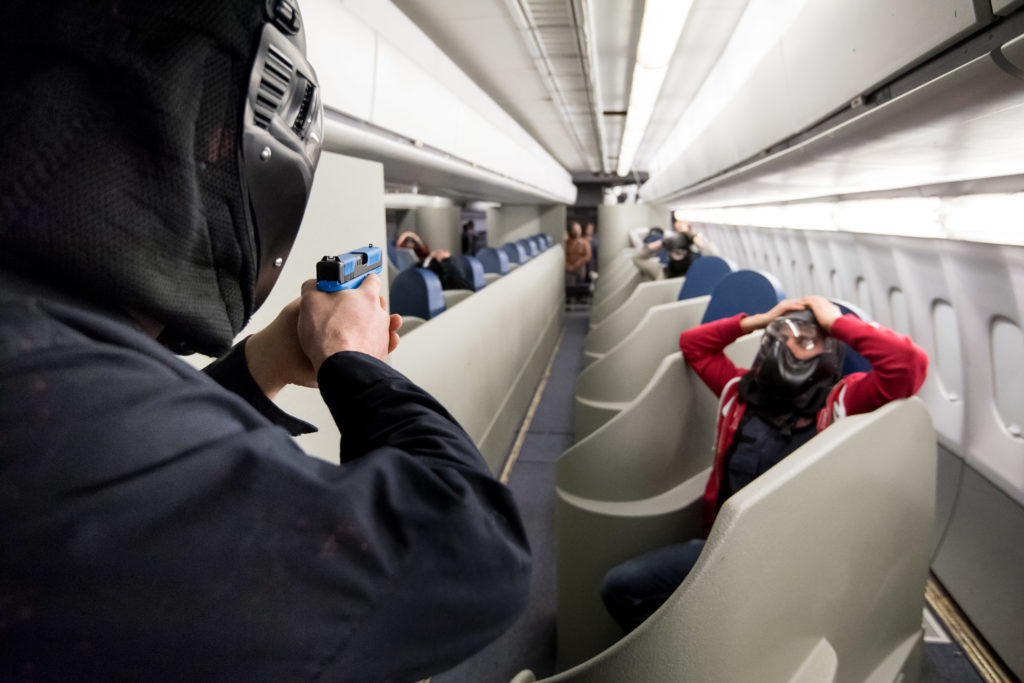
Ostensibly ordinary men and women, they are elite Royal Canadian Mounted Police (RCMP) personnel tasked with protecting the public, flight crews and other personnel against terrorists.
Popularly called “air” or “sky” marshals, their correct title is in-flight security officer (IFSO), and they are the sharp edge of the Canadian Air Carrier Protective Program (CACPP) on Canadian domestic, transborder or international flights when intelligence sources indicate a threat.
Recently, Skies was invited to the CACPP’s main base in the Ottawa area to see how IFSOs are trained for 28 days after rigorous multi-stage screening, and then recertified every six months to keep them current on new threats.
Every IFSO is, first and foremost, an RCMP officer with at least three years in front-line policing before being considered for the program.
“Getting into this program is very stringent,” said a senior officer. “It’s a very complex process and also the training itself is exceptional.”
The invitation to see it in action was on the understanding that no photographs would be taken and only selected senior officials would be identified. Otherwise, said RCMP Supt. Janis Gray, the CACPP director, “whatever you see, you can say.”

Housed in a fairly nondescript building, the base is home to a series of simulators and support facilities, including the top-secret National Operations Support Unit, which collects intelligence and deploys IFSOs when a threat is deemed credible.
The facility includes three aircraft hulls retired from service–a McDonnell Douglas DC-10 with its wings clipped to fit inside the building, a Boeing 727 and a small private jet–and an open floor-mounted cabin layout, and replica passenger lounge and jetway.
Then there are the simulators, one of them a life-size interactive video platform with a difference: it includes a ShootBack cannon which fires plastic balls at a stinging 120 feet per second.
Developed by a Belgian firm, McSira BVBA, the PRISm platform also features large screens fore and aft. Flight and cabin crews are shown moving about and anyone walking the length of the cabin moves almost seamlessly from one screen to the other.
Now used by “thousands of law enforcement, military and public safety personnel,” according to Brussels-based McSira, the PRISm technology yields “exceptionally realistic video-based environments for all aspects of firearms” with broadcast-quality “digital environments that are as close as you can get to the real thing.”
While that helps IFSO trainees to make split-second judgment calls, the software also can set them up for indecision and even fear, blind-siding them with surprises as they hone their skills.
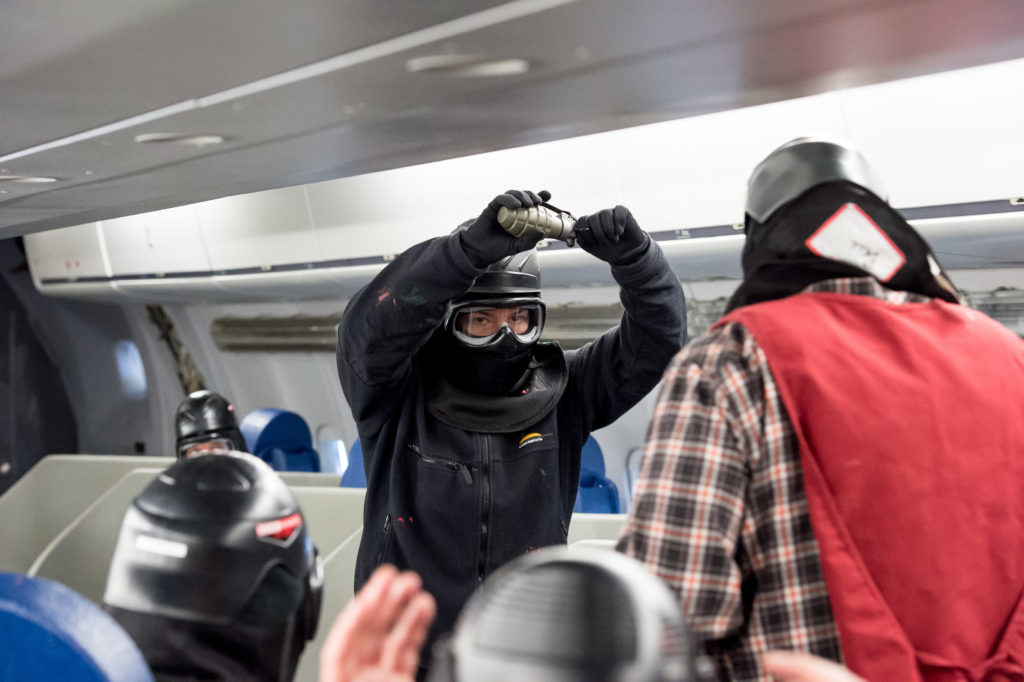
However, that doesn’t usually extend to dealing with disruptive passengers because airline crews generally can handle those. But a senior trainer explained that when extra help is needed, IFSOs can step up as able-bodied but otherwise anonymous passengers.
“Normally, when we intervene, it’s because potentially the integrity of the flight deck may be compromised,” said the officer. They also intervene when there is a threat of death or grievous bodily harm.
The scenario run for visitors was a Toronto-Seattle flight about an hour from touchdown. There was an outburst of yelling and screaming as an armed man jumped out of his seat.
Equally suddenly, someone shouted “gun,” followed by five rapid shots and then a series of loud “police, don’t move!” orders to everyone else by the two IFSOs who had shot the hijacker.
A senior trainer explained that the goal is to end the threat quickly, preferably not fatally, but “the whole idea is that you continue to react until the threat is neutralized.”
This also is an opportunity for instructors to examine the IFSOs’ covert behaviour–how they blend in–as other trainees realistically and unpredictably play out the threat role.
This involves constant analysis of other passengers from the time they arrive in a terminal and go through security, and how they behave in the passenger lounge and on board.
Part of the blending-in process for IFSOs–whose presence on Canadian carriers is known only to the command pilot because accessible cabin crewmembers can be coerced into identifying an IFSO–is the development of cover stories.
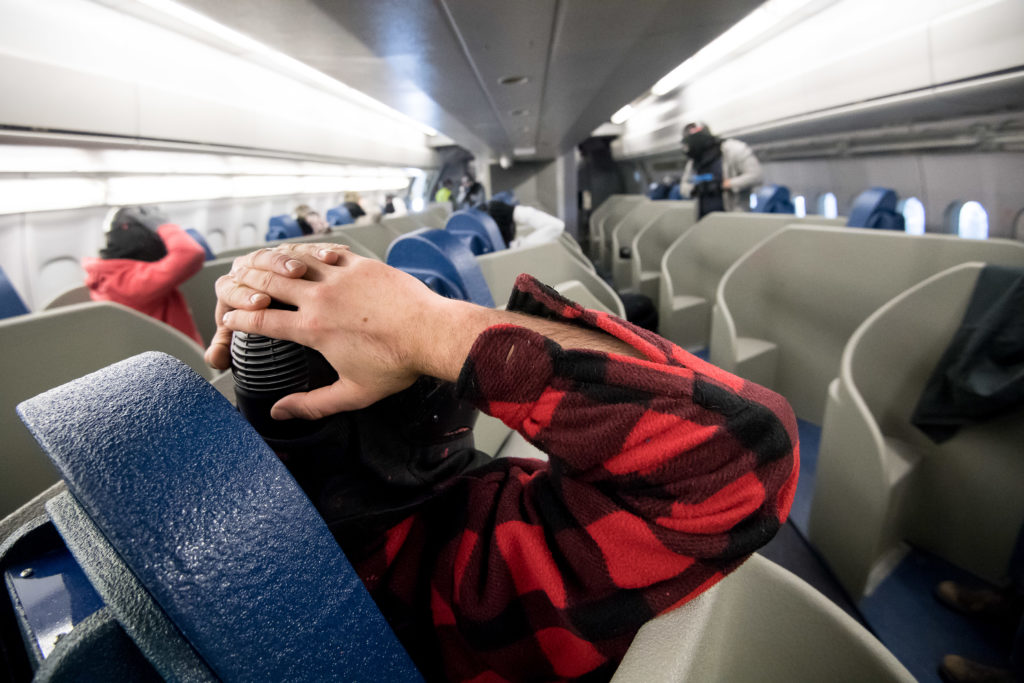
This includes what they ostensibly do, their destinations, duration of stay, etc., in the event a seatmate or someone else becomes too chatty.
“The whole time that they are working, they are being videotaped from the front and the rear,” the trainer said of the PRISm technology, which records all shots.
“Instead of the instructors, who are pretty hard-core, nailing people all the time on what they did wrong and what they did right and so on and so forth,” playback lets them see what they might have done differently.
“They end up correcting themselves, which ends up being the best correction rather than somebody else telling them,” said the trainer. “You’ve heard them saying that ‘a picture’s worth a thousand words’? Well, we think this is worth 10,000 words.”
From PRISm, trainees eventually move to scenarios involving live ammunition rather than the non-lethal “simunitions” used in the PRISm and elsewhere.
The open cabin replica and the hulls, which were purchased from carriers, essentially are used to refine trainees’ skills before they transition to live ammo.
In the larger hull, half of the cabin is a two-aisle configuration with conventional seating. The other half is set up with pods which present IFSOs with markedly different lines of sight.
In addition to shooting skills, IFSOs are trained in hand-to-hand combat in a sprawling gym complex. Visitors were treated to officers working with heavy boxing bags, fighting a mixed martial arts style based on Muaythai, which mixes stand-up striking and clinching, as well as taking down opponents armed with guns and edged weapons.
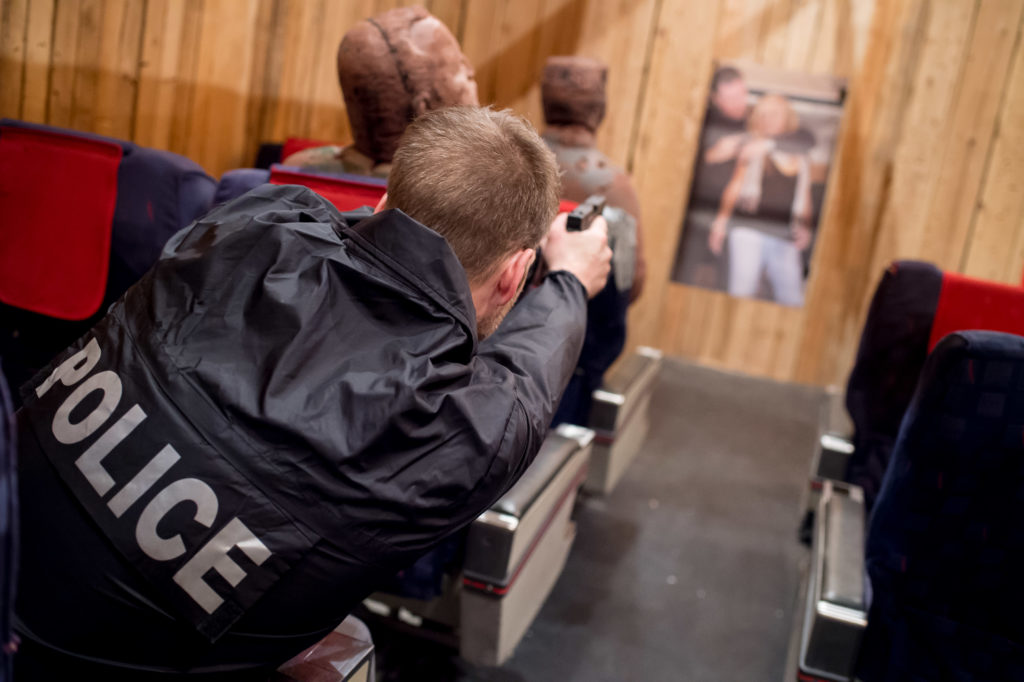
Although the edged weapons used in training are blunted, realism can be stepped up with a knife fitted with essentially the same technology as racquet-shaped mosquito zappers.
Developed by Winnipeg-based Shocknife Inc., which calls it “the only training knife in the world capable of inducing fear,” it replicates the sensation of being cut–literally and figuratively adding an even more realistic edge to the CACPP syllabus.
Development of what one trainer called “the warrior attitude” is critical in that some hijackers don’t use firearms, presenting a close-quarters challenge for IFSOs.
He paraphrased former world heavyweight boxing champion Mike Tyson, saying: “Everybody’s got a plan ’til they get popped in the mouth.” When that happens, “they stop in fear and freeze.”
An effective IFSO can’t afford to be surprised, and their training also includes how to deal with the threat of real or dummy improvised explosive devices (IEDs) which, as one trainer demonstrated, come in ever-evolving configurations.
He stressed that IFSOs are not bomb-disposal experts; the goal is to psychologically defuse a situation to the point where a hijacker can be subdued and the aircraft landed safely.
Asked whether the firearms training is different from what an ordinary RCMP officer would undergo, in terms of which parts of a hijacker they aim for, a trainer told Skies that “they shoot to stop the threat … they shoot to kill.”
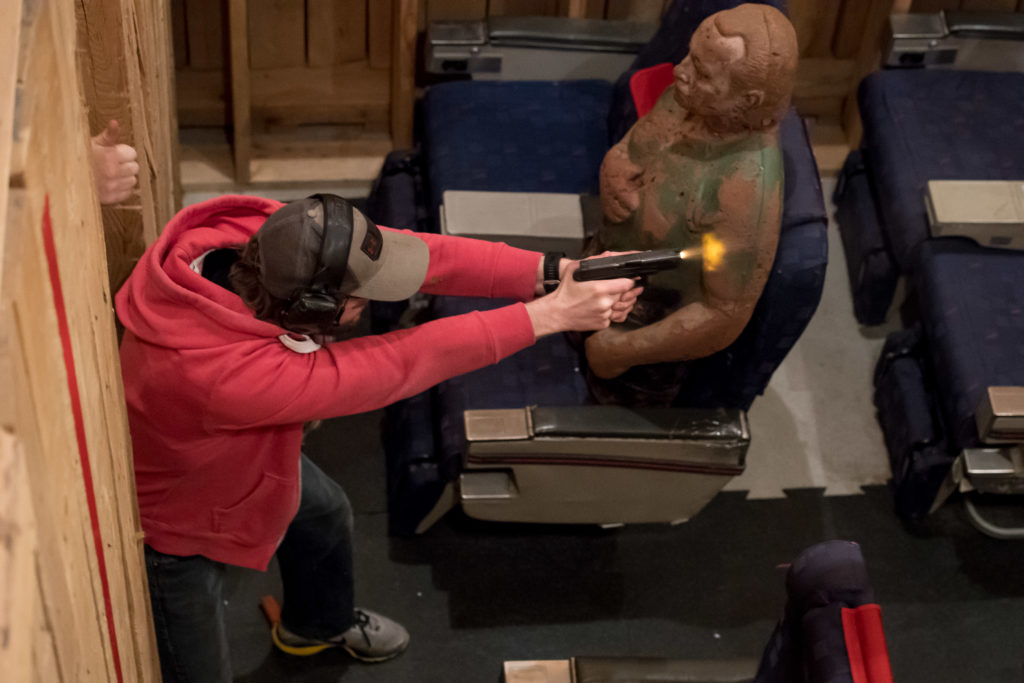
The RCMP’s program, which was set up in the aftermath of the September 2001 airliner attacks in the United States, has become so refined that Canada often becomes a “best practices” resource for other countries who want to maintain their IFSOs’ currency.
Canada is the current chair of the International In-Flight Security Officer Committee (IIFSOC) comprised of the nine founding members (Australia, Austria, Canada, the Czech Republic, France, Germany, the Netherlands, Switzerland and the United States) as well as India, Israel, Jordan, Poland, Romania, Singapore and the United Kingdom.
Some countries, notably Israel and its EL AL flag carrier, had programs in place long before 9/11 (the U.S. has had air marshals since 1962) but have since opted to enhance them in response to new and evolving threats.
Some might argue, given the remarkable decline in the number of hijackings and other incidents in recent years, that the costs of IFSO programs are no longer justifiable.
Canada’s costs are covered within the RCMP’s operational budget ($1.84 billion in the 2017-2018 fiscal year), but there’s also the reality that insurance of any kind can be expensive–until it’s needed.
However, when the enormous cost of one downed aircraft and the resulting expenses associated with insurance payouts and lawsuits, etc., are contemplated, that argument quickly withers. Airlines and their passengers would likely agree.





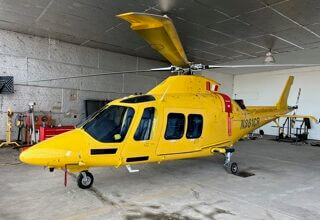



How do i become sky marshal